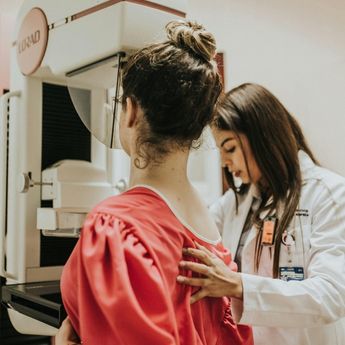by Adriana Ermter
In our monthly column, senior writer and editor Adriana Ermter shares her personal experiences with breast cancer.
Because I’m a born and raised Canadian, I just assumed I would have access to all sorts of free testing and screening when I found the hard, pea-sized lump in my right armpit. Not so much. Here’s how my breast cancer-screening steps went.
I booked an appointment with my GP. She felt the lump, agreed with me that it was unusual, and immediately scheduled me an appointment at a free breast cancer clinic in downtown Toronto. So far so good. Once at the breast cancer clinic, a myriad of doctors—it’s a teaching hospital and clinic—pressed their fingers into my flesh to feel the lump nestled just below the surface of my skin. After everyone had their turn, the lead doctors determined that the lump was nothing. I disagreed and asked for a mammogram and for an ultrasound. I was given my first-ever mammogram, albeit begrudgingly, but not the ultrasound.
The mammogram showed nothing beyond the possibility of calcification, which are small deposits of calcium that can show up on a mammogram as bright white specks or dots on the soft tissue background of the breasts. Breast calcification is not a sign of breast cancer, but it can be an identifier that something is occurring in the breast tissue. The mammogram also revealed that I have dense breasts—higher amounts of glandular and fibrous connective tissue with relatively low amounts of fatty breast tissue—making it harder to detect cancer in mammograms as dense tissue and cancer can both appear white on the imaging screen. According to the Canadian Cancer Society, having dense breasts increases the risk of breast cancer; facts the doctors did not share with me at that time.
So, it was beyond my understanding why I was refused an ultrasound to screen the lump residing in my right armpit, especially considering it couldn’t be squeezed between the mammogram’s steel clamps. When I asked, I was told I was too young to worry about breast cancer. I didn’t have the telltale signs of a misshapen breast, swelling, nipple discharge, redness, orange peel-like skin, dimpling, a sunken nipple, or even a familial history. And so, I was sent home. For the next 180 days, I politely stalked the clinic calling them every single month requesting an ultrasound. Six months later, when I was finally granted more screening, including an ultrasound, I was diagnosed with breast cancer.
No one should have to wait for answers and to be taken seriously, particularly when it comes to a suspected cancer. And yet, too many women like me, who are under the age of 50 when they find their lump, are forced to jump through hoops to receive proper and appropriate breast cancer testing.
According to Partnership Against Cancer, Canada’s current breast cancer screening guidelines start at the age of 50 and end at age 74, 75 or 76, allowing asymptomatic individuals with an average risk, one free mammogram every two years. While some provincial jurisdictions accept individuals outside of these guidelines, this will typically only happen if the individual has been identified as high risk and is showing the typical signs of breast cancer and/or they have been recommended by their doctor. So, while we wait for these outdated screening guidelines—created courtesy of a study from the 1980s—to change, there are options that can provide you with the services and knowledge you need now. Because in my opinion, whether you’re diagnosed with breast cancer or not, screening is always better and less stressful than not screening and not knowing or not having insight into your own health.
Know Your Screening Rights
The most important thing to know is what types of screening you can access, where, and when. Dense Breasts Canada has a comprehensive guide to breast cancer screening for Canadian women in their 40s that is a fantastic resource. The Canadian Cancer Society also provides helpful insight for women 50 years and older, while Rethink Breast Cancer reminds all of us, especially women in their 20s and 30s, to be breast cancer aware, to be our own health advocates and to understand how to use screening insight to our advantage.
Factors to Consider
In some cases, you might advocate to access breast cancer screening by paying for it. Before you open your wallet, it’s important for you to determine your own personal set of pros and cons regarding paid breast cancer screening.
- The cost. Private breast cancer screening services come at a cost, so consider your budget and evaluate whether the benefits outweigh the financial implications.
- Insurance coverage. Check your health insurance policy to see if it covers private screening services. Some policies may partially or fully reimburse the cost, making screening more accessible.
- Medical recommendations. Consult your healthcare provider before opting for private screening, especially if you have specific risk factors or medical history. They can provide guidance on the most suitable screening methods for your situation.
- Accreditation and expertise. Choose a reputable screening facility with experienced radiologists and technologists. Look for accreditations and certifications to ensure the facility meets high standards of quality and safety.
The Benefits of Paid Breast Cancer Screening
What you can expect to receive at most private clinics.
- A timely appointment. Private screening companies often offer quicker appointment scheduling, ensuring that you can access screening at your convenience.
- Comprehensive services. Paid screening services often include a range of imaging options, such as 3D mammography and breast MRI, providing a more detailed and accurate assessment of your breast health.
- Personalized care. Private facilities prioritize individualized care, offering a more comfortable and private environment during the screening process.
- Additional services. Such as genetic testing and counseling to help you understand your risk factors and make informed decisions about your health.
Paid or Partial Pay Screening Options
While a Google search will show you more options for paid clinics in your province, here are three that provide reputable service for your health’s sake.
Located in the city’s downtown core, the centre is the first dedicated medical imaging clinic in Ontario offering automated breast ultrasounds (ABUS). Traditional mammograms and ultrasounds are also available.
Cost: Approximately $230 for 3D imaging.
With several clinics across Canada, the facility offers comprehensive breast imaging services, including 3D mammography and breast ultrasound. Their expert radiologists and technologists provide accurate and timely results.
Cost: Free when covered under provincial healthcare, depending on which province you live in.
With locations in British Columbia, this clinic specializes in various medical imaging services, including mammography. They emphasize patient comfort and utilize cutting-edge equipment for precise and efficient breast cancer screenings.
Cost: Approximately $140-$360 for one breast mammogram; $170-$430 for two breasts mammogram.
Adriana Ermter is a multi award-winning writer and editor. Her work can be read in Figure Skater Fitness, Sotheby’s Insight, Living Luxe and IN Magazine, as well as online at 29Secrets.com, RethinkBreastCancer.ca, Popsugar.com and AmongMen.com. The former Beauty Director for FASHION and Editor-in-Chief for Salon and Childview magazines lives in Toronto with her two very spoiled rescue cats, Murphy and Olive. You can follow Adriana on Instagram @AdrianaErmter







